National Connection
The purpose of this page of the website is to provide a summary of the history of National Express, it’s connection to CRG163 and me and especially as it celebrated 50 years of existence in 2022.
The National Bus Company (NBC) years and the introduction of National Travel - NATIONAL & National Express
From the 1st of January 1969 a significant change took place to the UK bus industry with the introduction of the National Bus Company (NBC). This involved the merger of the Transport Holdings Company (THC) and the British Transport Commission (BET) organisations into a single National Bus Company (NBC) following the White Paper recommendations forming a part of the Transport Act 1968.
The NBC inherited 75% shareholdings in chassis manufacturer Bristol Commercial Vehicles and body builder Eastern Coach Works from the THC. Also in 1969 NBC formed a joint venture with British Leyland who owned the other 25% of Bristol and ECW, designing the Leyland National.
After the creation of the National Bus Company, but before the launch of the 'National' coach branding, the NBC began producing its own express services timetable book which at the time was named "Britain's Express Coach Guide". This replaced the 'ABC Coach and Bus Guide' which had been the bible for booking and enquiry office staff all over Britain and, like the ABC, featured timetables of numerous independent express service operators.
 Britain’s Express Coach Guide - Summer 1972.
Britain’s Express Coach Guide - Summer 1972.Under the NBC, buses would be operated by locally managed subsidiary companies. In the early years of the National Bus Company, there was some rationalisation, generally leading to the amalgamation of operators into larger units and the transfer of areas between them. As a part of this Crosville took over the former North Western depots of Northwich, Macclesfield and Biddulph as well as the former Western Welsh depots in New Quay and Newcastle Emlyn.


UK map showing the National Bus Company’s subsidiary bus companies, their headquarters location, and their operating boundaries as at 1 January, 1974.
Following the appointment of Frederick Wood as chairman in 1972, NBC introduced a corporate identity. This was launched on the 10th of April 1972. Under the leadership of Sir Wood, the National Bus Company moved to bring together all of the scheduled coach services operated by its subsidiary companies across the UK under one network brand in 1972. From this point coaches would be branded as National Travel and painted in white, with the NBC logo and the 'NATIONAL' name in alternate red & blue letters added as shown below. This would include a new logo created by designer Norman Wilson in the shape of the letter ‘N’ for National in red, but with a mirrored shadow ‘N’ underneath in blue. This was a truly iconic logo that became synonymous for over 30 years between bus and coach travel in the UK.

Whilst the logo was no longer used on vehicles operating local bus services beyond deregulation and privatisation of the National Bus Company it continued on longer distance coach express services under the National Express brand until such time when National Express changed their logo in 2003. Further details of Norman Wilson is available through the nationalbusmanual.com website.
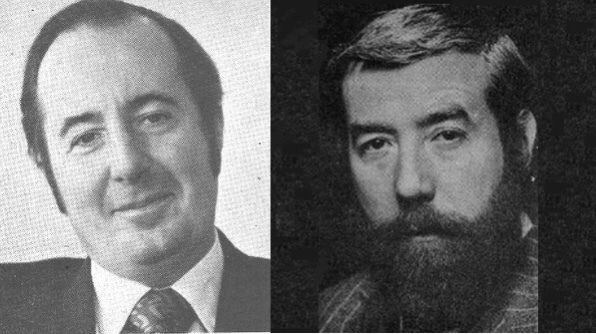
Sir Frederick Wood (left) and Norman Wilson (right). Photo courtesy of the Bus Archive/NBC Corporate Identity Project.
 NATIONAL’s Britain’s Express Service Guide - Winter 1973/74.
NATIONAL’s Britain’s Express Service Guide - Winter 1973/74.The inspiration came from the Unitied States which since the 1940’s operated a network of national coaches under the banner Greyhound.

Three Greyhound adverts/posters from the late 1940’s and early 1950’s.
CRG163 was one of the first Crosville coaches to be repainted into the all white NATIONAL corporate livery in late 1972.
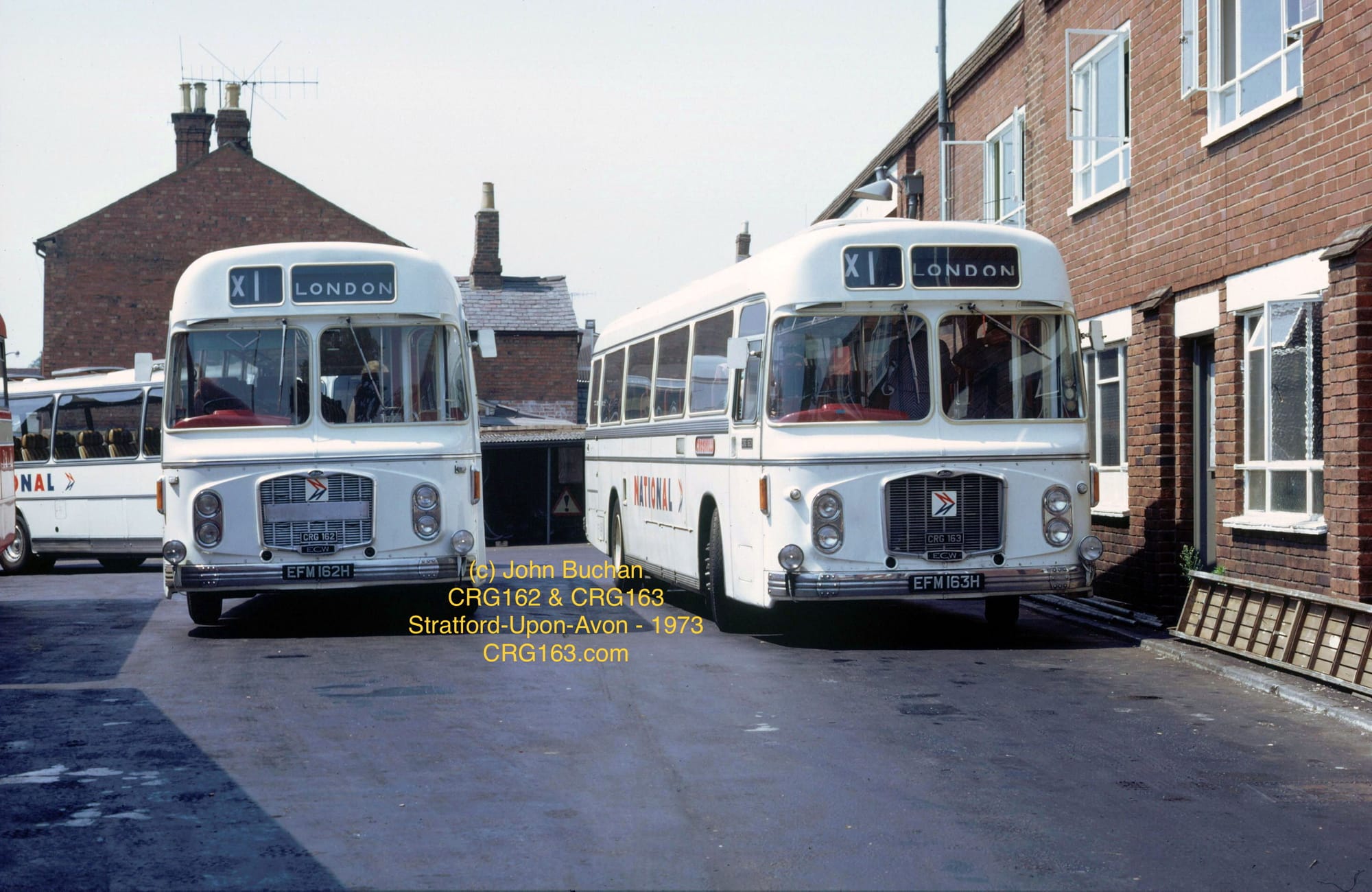 CRG162 & CRG163 at Stratford-Upon-Avon in 1973. Both vehicles operating NATIONAL service X1 to London.
CRG162 & CRG163 at Stratford-Upon-Avon in 1973. Both vehicles operating NATIONAL service X1 to London.CRG163 continued in this livery until 1979 when downgraded to NBC dual purpose (DP) status in 1979. The story of CRG/ERG163 is captured elsewhere on this website.
Sir Frederick Wood remained as chairman of the group from 1972 to 1978 and was knighted in 1977. More information about Sir Wood is available by clicking HERE .
A glimpse into NATIONAL services in the early to mid 1970’s is available on You Tube courtesy of the Huntley Film Archives (archive film 62650). It depicts a coach trip on a Plaxton Elite Bristol RELH coach in the then National white livery and branding leaving the Victoria Coach Station, London.

To see this video either click on the image above or click HERE.
National Holidays
National Holidays (the original company) also had white coaches with a red and blue brand but separate to National Express and co-ordinated the coach activities of the National Bus Company, formed in 1976. It was purchased by Pleasurama in July 1986 as a part of the privatisation of the National Bus Company. Jenkins, Skewin was subsequently purchased in 1988.
National Holidays was rebranded as Shearings National in 1989 when Mecca Leisure Group purchased Pleasurama, merging National Holidays with Shearings. Mecca was taken over in 1990 by the Rank Organisation. This added the business of Eagle Coaches - Tunbridge Wells and Gwalia Coaches - Llandudno Junction the same year. Rank sold Shearings Holidays to a management buyout in 1996.
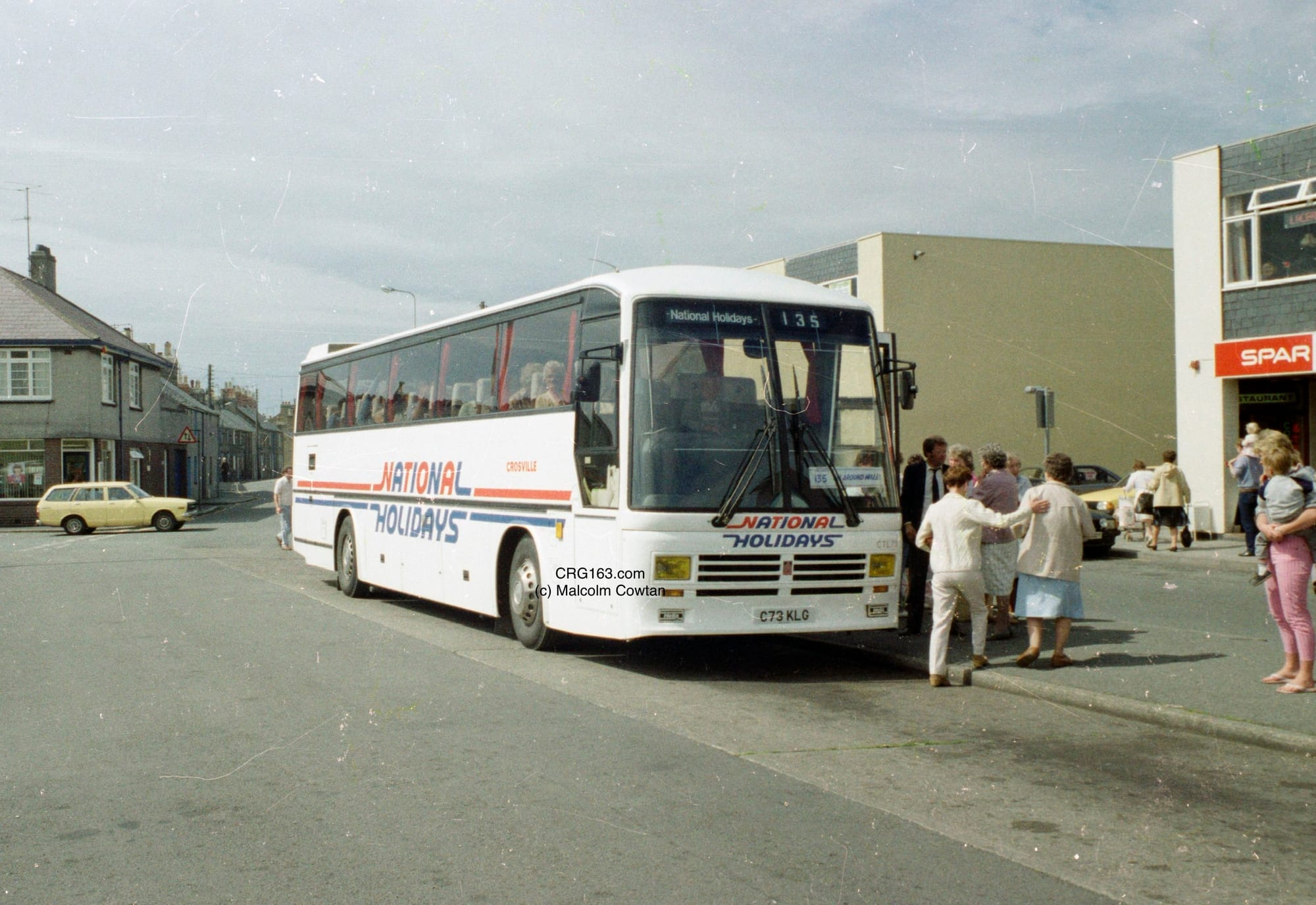 Crosville CTL73, (C73 KLG), Leyland Tiger with Duple 340 body stands at the original Pwllheli, North Wales bus station on the Maes (Square) mid 1980’s.
Crosville CTL73, (C73 KLG), Leyland Tiger with Duple 340 body stands at the original Pwllheli, North Wales bus station on the Maes (Square) mid 1980’s.Change of branding
The ’NATIONAL’ brand would be superseded eventually by the National Express identity shown below. The National Express identity first appeared on coach guides in 1974 before appearing on coaches in 1978.
 National Express services guide - Summer 1974.
National Express services guide - Summer 1974.
 National Express services guide - Summer 1979.
National Express services guide - Summer 1979.Transport Act 1980 and Competition
On the 6th of October, 1980 travel was deregulated under the Transport Act 1980. The introduction of this act ended the licensing regulation imposed on express coach routes and tours over 30 miles. This resulted in the introduction of competition between publicly owned National Express and private companies. Coach services in Scotland, including routes between Scotland and England, were operated by the subsidiaries of the Scottish Bus Group (SBG), which was also state-owned. The act also allowed county councils to set up ‘trial areas’ in which road service licences were no longer required, allowing operators the opportunity to operate services on any route they wished.
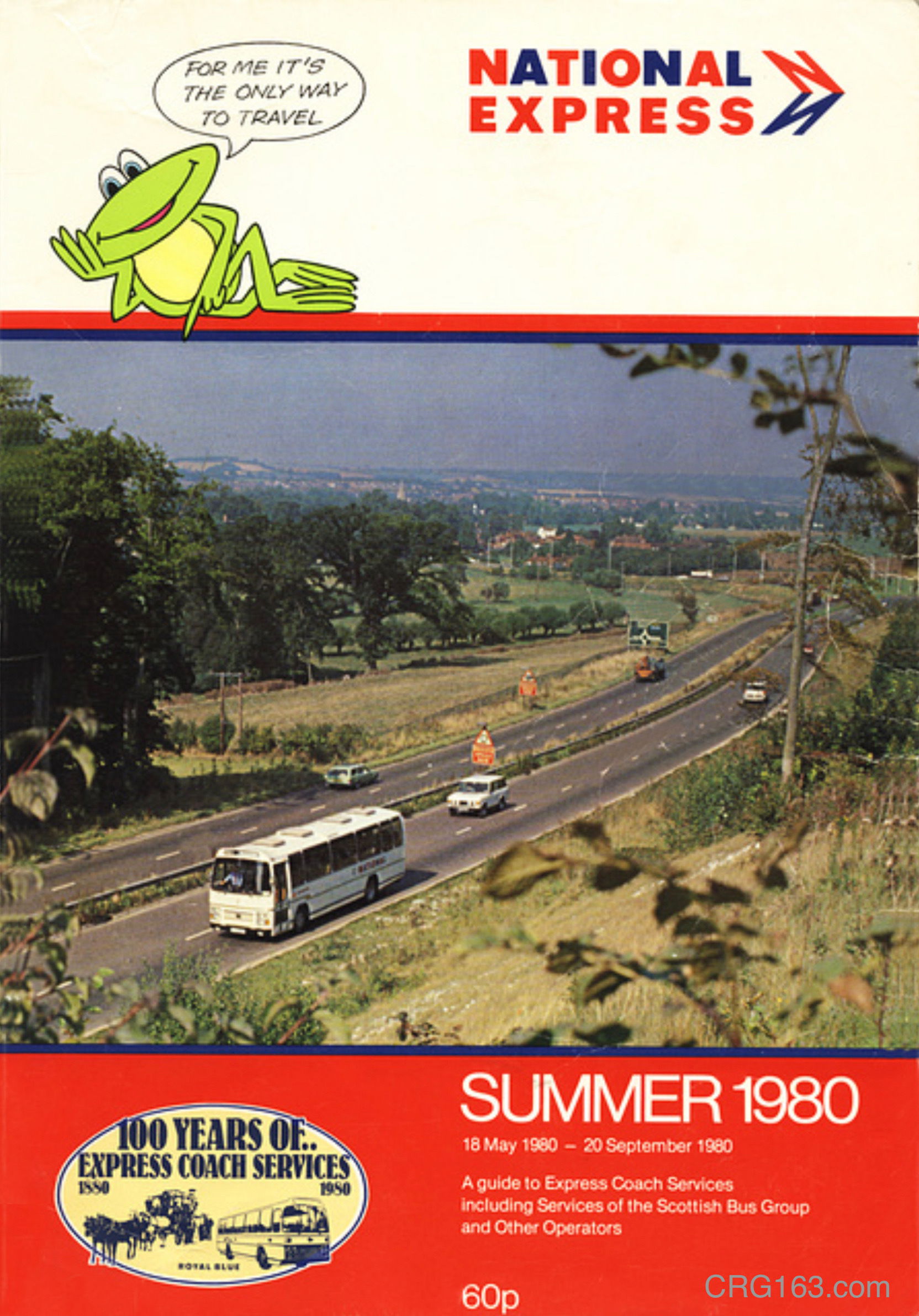 National Express services guide with Beep the Frog - Summer 1980.
National Express services guide with Beep the Frog - Summer 1980.British Coachways
In the early years of National Express it had little competition in the long distance coach market. However after deregulation of coach travel following the introduction of the Transport Act 1980 a number of operators attempted to compete but many had ceased by the end of the decade. One of the competitors was the British Coachways consortium consisting initially of six of independent coach companies across the UK. These were Wallace Arnold; Grey-Green; Shearings; Morris Bros; Ellerman Bee Line and Park’s Motor Group. their combined fleet mounted to approximately 700 vehicles. The consortium were keen to present a nationwide image and adopted the colours of red, white and blue (shown below) with some coaches receiving this livery and branding.

Logo used by British Coachways between 1980 and 1982.
British Coachways commenced operation on the day of coaching de-regulation and immediately charged very low fares. National Express responded to this fare policy with a similar response in Scotland. By April 1981 members if the consortium began to pull out. British Coachways was dissolved in October 1982 led to the withdrawal of all but one of its former routes by the surviving constituent companies. Many consortium members went on to operate services on behalf of National Express. The inly route that continued was the London-Poole service operated by Excelsior. This continued in competition with National Express until February 1998 before being taken over. The Transport Act 1980 caused National Express’ market share to temporarily reduce, however in real terms passenger numbers increased.
Significant competition against National Express by independents had reduced to only two routes by 2001 which included the route between London and Glasgow. However in 2003 Stagecoach introduced its Megabus brand and network of services. this would provide more frequent services over more routes than previously provided by the British Coachways. Megabus introduced a price war with National Express in 2004 with Megabus fares advertised as only £1 for those booking early to travel on services. Competition between both companies continues to this day which was intensified in 2007 when Megabus changed its terminus in London to the Victoria Coach Station from the Green Line Coach station.
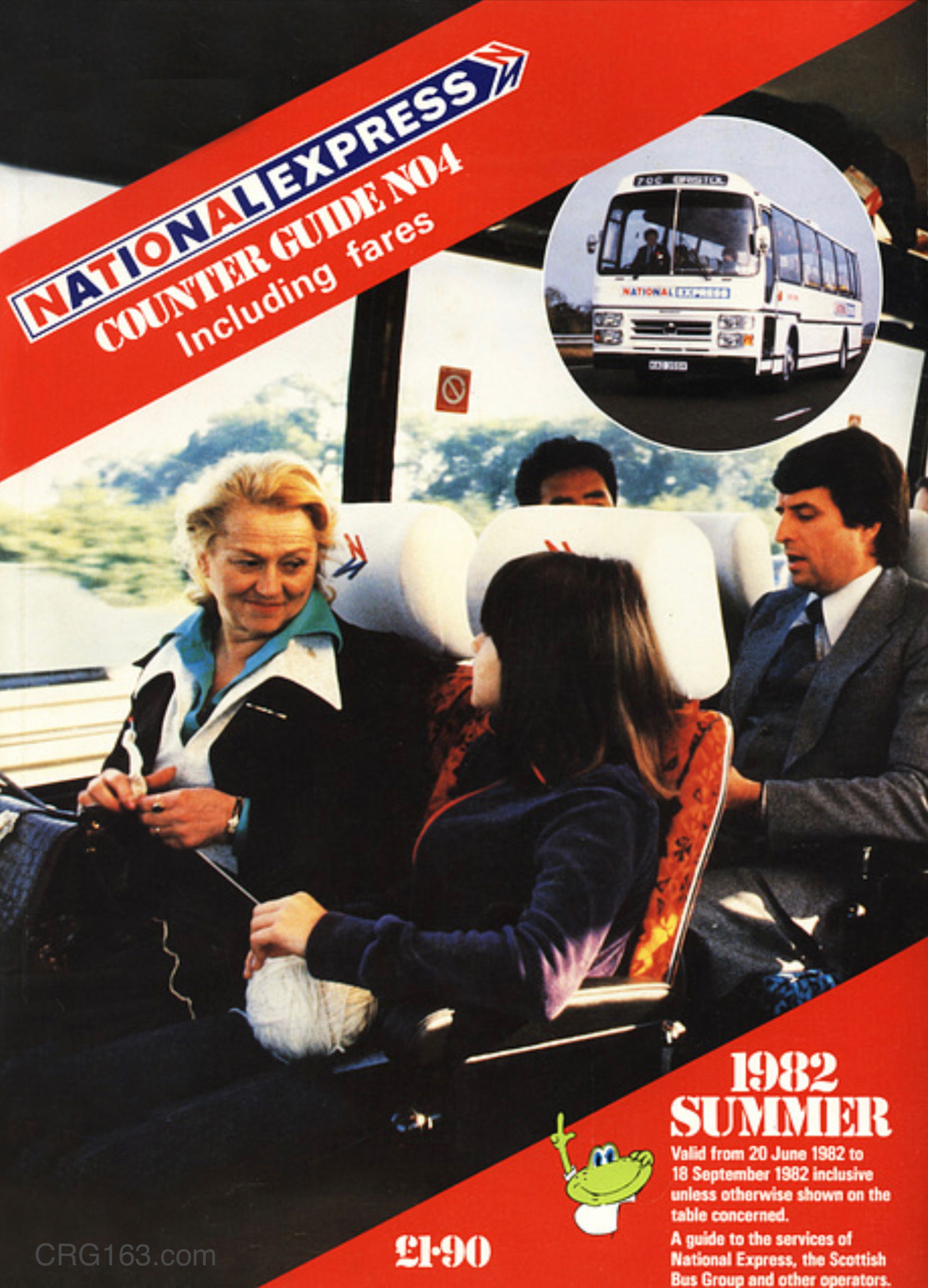 National Express services guide - Summer 1982.
National Express services guide - Summer 1982.Transport Act 1985 - Deregulation and Privatisation
One of the biggest upheavals to impact the bus industry in the UK in modern times was the introduction of the Transport Act 1985 on the 25th of October 1986. This would have significant and far reaching consequences on the National Bus Company and National Express.
The provision of the Act brought with it two distinctive parts:
- Part 1 - deregulation, replacing service licensing with a system of registration, allowing bus companies to charge any fares they wished (on commercially operated services, i.e. bus services operated at the cost of the operator) and creating a free market in which bus companies with an operating licence could decide and register commercial services with the traffic commissioner between any points. Local authorities would then fill the gaps in commercial networks by tendering and then subsidising services not operated commercially based upon their local assessment of local needs. Deregulation did not occur in Greater London in the same way. This was based on a franchising system, operated by private companies but managed by London Buses Ltd.
- Part 2 - privatisation of public sector owned bus companies under the umbrella of the NBC. In essence this was the end of the road for the National Bus Company. It was subsequently divided into seventy units and sold off to the private sector, commencing with National Holidays in July 1986 with the last sale being completed in April 1988.
 National Express Coach Guide - Summer 1987.
National Express Coach Guide - Summer 1987.National Express beyond the NBC and into the privatised new world
Following the introduction of the Transport Act 1985 the National Bus Company was divided into 70 units. The first sale was National Holidays to Pleasurama in July 1986. The last sale was completed in April 1988. National Express was subject to a management buy-out in March 1988 In the same way as all of its subsidiary companies.

The future of the famous “double-N” logo
The break up of the National Bus Company into 70 separate units and subsequent sale of each of these units brought to an end the corporate liveries and imagery that were introduced on the formation of the National Bus Company. Individual new liveries of privatised companies emerged, keen to make their own presence known and subsequent branding. This resulted in the slow withdrawal of the "double-N" logo introduced on the 10th of April 1972 from all vehicles and premises now operating under new companies and management. However the “double-N” logo was maintained by National Express when sold to its management and continued to be used until 2003, 31 years after its initial introducing when the famous NBC logo finally disappeared to make way for a new logo, it itself replaced in 2007. The “double-N” logo is still owned by National Express and trademarked with special permission being sought and given for its use on preserved CRG163 and this website with much thanks.
The various logos and branding used by National Express over the past fifty years are shown lower down on this page including the dates in which they were used.
National Express expansion
Following the purchase of National Express the management of the newly acquired company decided to diversify its portfolio. Not only had Crosville Motor Services and Crosville Wales had a long standing connection with National/National Express in operating services on it’s behalf, National Express would go on to purchase Crosville Wales in 1989 and become its parent company.
In June 1989 National Express Holdings acquired Amberline Ltd. of Liverpool which was placed under direct control of Crosville Wales by its parent owner. This resulted in financial pressure placed on the fledgling Crosville Wales company, itself purchased by its own management in the same way as National Express post deregulation and itself attempting to operate in the brave new world of privatisation. Suffice to say this did not bode well.
In July 1989 ATL Holdings was purchased (with Sheffield operations) with 50% in Yelloway Trathen, which was renamed Trathens Travel Services.
In October 1989 National Express acquired the Scotland-England coach services of Stagecoach and created a Scottish subsidiary with the brand of Caledonian Express.
National Express Annual Report 1991
In 1991 a new management team headed up National Express with the backing of the private equity firm, ECI Partners, deciding to concentrate on its core activities. Crosville Wales was sold to British Bus in July of the same year with National Express purchasing Speedlink which was a coach operator between Gatwick and Heathrow Airports.
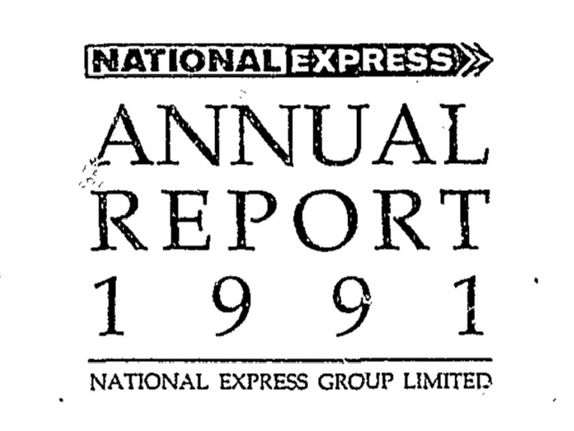
The National Express Annual Report, 1991 provided the company’s present position (at the time) and its intended future direction as noted in the report’s forward and the Chairman’s Review section by Mr P R McEnhill on the 28th April, 1992. The text of both sections of the report have been reproduced below. Other sections of the report including financials have not been included due to the size of the report.
Report Forward
National Express is the largest operator of long distance scheduled coach services throughout the United Kingdom. It is a unique business with an extremely well recognised brand name, and for many people it represents the only alternative to rail as a means of long distance travel.
National Express accounts for about 80% of all scheduled coach services in this country, serving 1,500 destinations, and as in the sole UK member of Eurolines which operates an expanding network of scheduled express coach services from London to over 270 destinations in 15 countries.
National Express also operates Speedlink, which provides high-quality interlinking coach services between London airports, together with other airport services, Jetlink and Flightline.
Express Travel comprises the group’s in-house coach operations. The majority of National Express services are contracted out to some 80 operators, mostly regional bus companies, but many are independent coach companies. National Express devise the network of services, markets them, contracts out their operation, and ensures the maintenance of quality standards.
Chairman’s Review
On the 23 July 1991 National Express Group Limited acquired National Express Holdings Limited and all its subsidiaries, other than a sub-group principally comprising Crosville Wales Limited, a regional bus company, and Amberline Limited, which operates local buses and certain contracts on behalf of National Express Limited.
The initial objective of the new owners and management if National Express Group has been to focus the group closely on three key businesses:
- the operation of a national network of long distance coach services - the National Express business
- participation in the operation of long distance coach services in continental Europe - the Eurolines (UK) business
- the operation of coaches on National Express contracts - the Express Travel business

National Express Annual Report 1991
Steps taken since July 1992 to achieve this logical grouping included the disposal of stakes of joint venture coach operating companies and the consolidation of all the retained coach operating subsidiaries under the Express Travel name and organisation.
National Express was floated on the London Stock Exchange on the 1st of December 1992 for a price of 165p per share.
 National Express Coach Guide - Summer 1992.
National Express Coach Guide - Summer 1992.The National Express Group was sold to the Drawlane Transport Group plc with it’s assets taken over by British Bus plc in early 1993 following the floatation of National Express in 1992. In August 1996 Cowie purchased British Bus.
Further expansion
In 1993 Scottish Citylink, East Midlands Airport and Eurolines were acquired with West Midlands Travel in 1995, rebranded Travel West Midlands in September 1996.
In March 1996 National Express acquired the Manchester-Birmingham-Heathrow-Gatwick express coach services of Birmingham based Flight’s Travel Group which included the ‘Flightlink’ brand name. The branding was expanded to cover a number of National Express services that linked different regions of Britain with key airports including the services from South Wales.

During 1996 National Express diversified into rail operations in the form of Gatwick Express and Midland Mainline. In 1997 Silverlink, Central Trains and ScotRail were won.
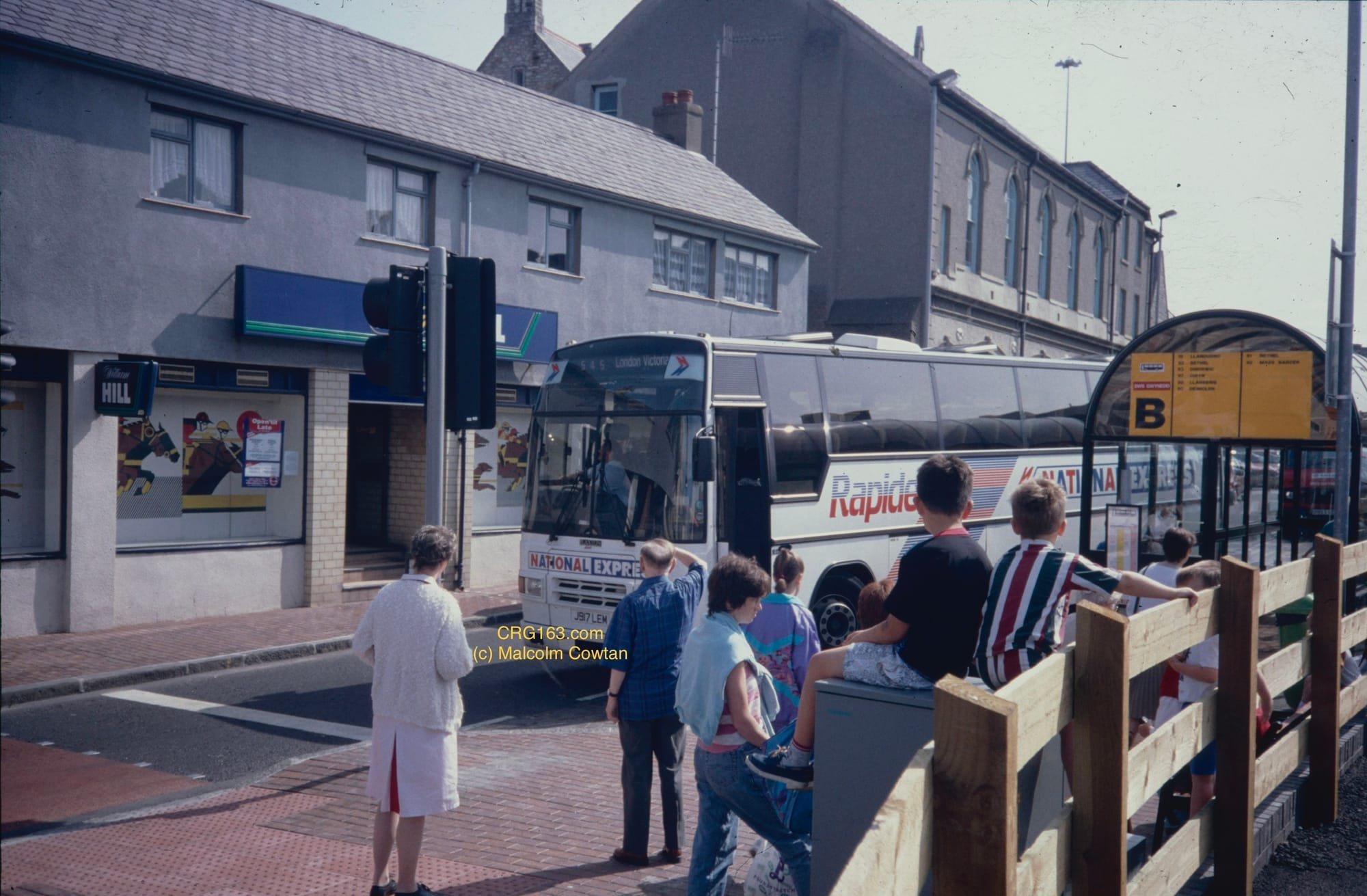 J917 LEM, a VOLVO B10M, Plaxton 3500 Expressliner coach departing Caernarfon bus station (Pool side) in the early 1990’s on National Express Rapide 545 service to London.
J917 LEM, a VOLVO B10M, Plaxton 3500 Expressliner coach departing Caernarfon bus station (Pool side) in the early 1990’s on National Express Rapide 545 service to London.In February 1997 Taybus Public Transport was acquired and rebranded Travel Dundee. Scottish Citylink was sold in 1998 to Metroline due to the Monopolies & Mergers Commission ruling on its winning of the Scottish Citylink around competition concerns. In September 1998 National Express ventured across the water to the United Sates by acquiring Crabtree-Harmon.
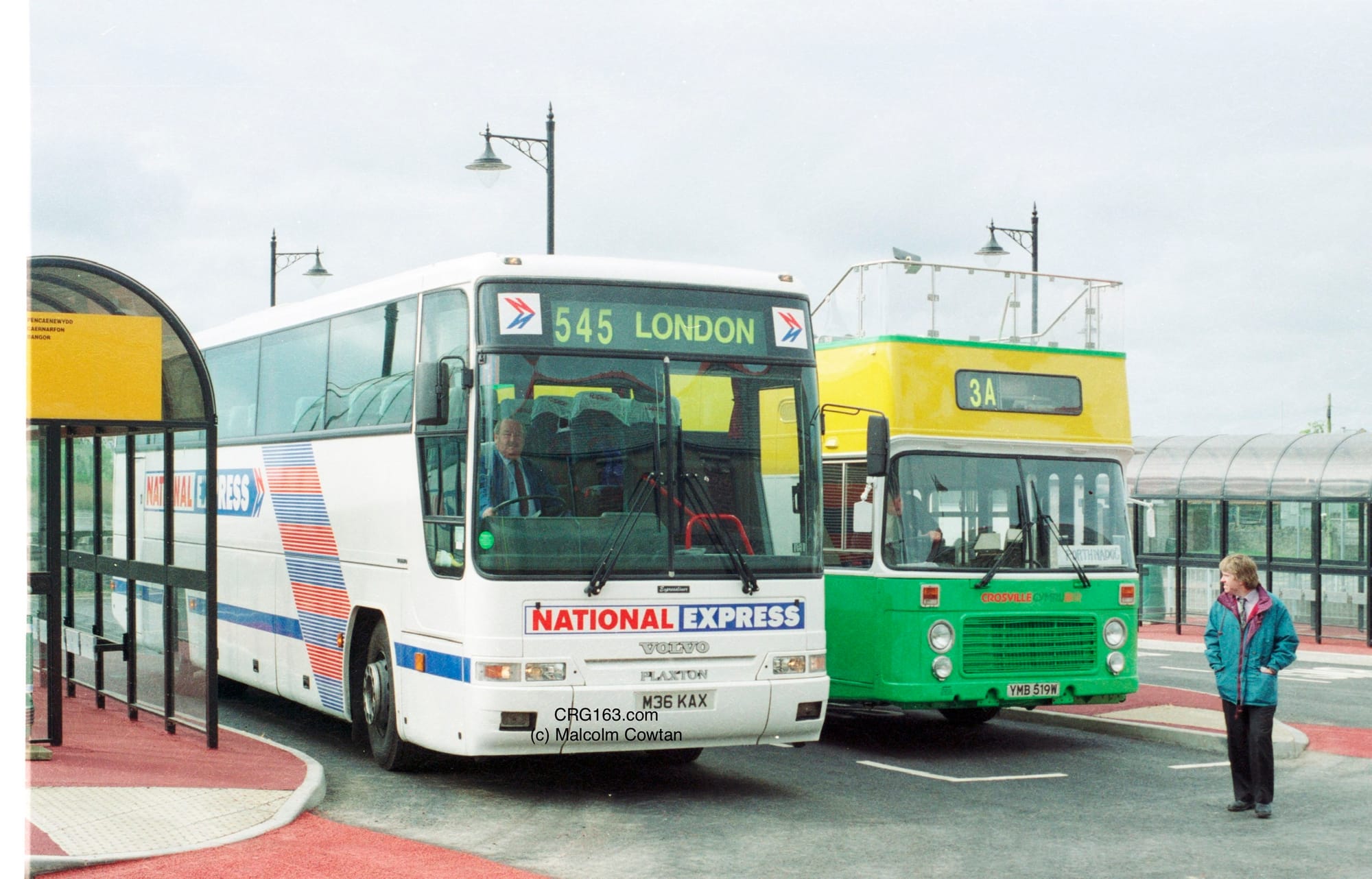 M36 KAX - BEBB’s of Llantwit Fadre VOLVO B10M, Plaxton Premiere 350 about to leave Pwllheli Bus station on the National Express 545 service to London with Gwilym ‘Berch’ Williams at the wheel. Also pictured right, Dewi Roberts (Gwynedd County Council), previous driver and manager at Crosville Motor Services having driven many miles himself on National Express services across the UK back in the day.
M36 KAX - BEBB’s of Llantwit Fadre VOLVO B10M, Plaxton Premiere 350 about to leave Pwllheli Bus station on the National Express 545 service to London with Gwilym ‘Berch’ Williams at the wheel. Also pictured right, Dewi Roberts (Gwynedd County Council), previous driver and manager at Crosville Motor Services having driven many miles himself on National Express services across the UK back in the day.During 1999 Robinson Bus Service was purchased in February; Australia’s largest private bus company - National Bus Company in May; and Durham Transportation in August 1999. Also in the same month National Express won the M>Tram and V/L Passenger rail franchise in the Australian state of Victoria.
In August 1999 the Eurolines services from London to Europe (Alicante, Barcelona and Paris) was purchased from Wallace Arnold.
Airlinks/Jetlink (owned by National Express) acquired the Cambridge Coach Services (CCS) business in October 1999 and subsequently introduced a turquoise based livery which replaced their green and yellow style. Jetlink and Speedlink were original brands of Airlinks (The Airport Coach Company).
January 2000 saw National Express expand again by acquiring ATC, an American public transport operator. In the same year Prism Rail was purchased in July adding the c2c, Wales &Borders, Wessex Trains and West Anglia Great Northern franchises to the company’s portfolio. However in December 2002 the company withdraws from the Victorian rail franchise having not being able to renegotiate financial terms with government.
During 2003 National Express adopted a new logo and type font that would replace the long established and famous double ‘N’ logo designed by Norman Wilson. This is represented further on this page. The new logo comprised of of a red and blue circle with a white arrow linking both, representing people moving from one place to another. The new logo only lasted four years, being dropped in 2007.

2004 saw further developments and withdrawals. In February Connex was acquired and rebranded Travel London. In April National Express Wast Anglia commenced operations on the Greater Anglia rail franchise. In September of the same year the company’s Brisbane, Melbourne and Perth bus operations in Australia were sold.
June 2005 saw the purchase of Telling-Golden Miller’s bus operations which was rebranded Travel London. The following month of July saw the company sell its American public transport operator ATC to Connex.
Further in the same year National Express took on the majority of ALSA’s bus and coach services in October 2005 in Spain, Portugal and Morocco and it’s long distance operations to other parts of Europe. South America and China services were retained by the previous owner post acquisition.
During 2006 National Express launches its first fully accessible coach on its network in the form of a Caetano Levante.
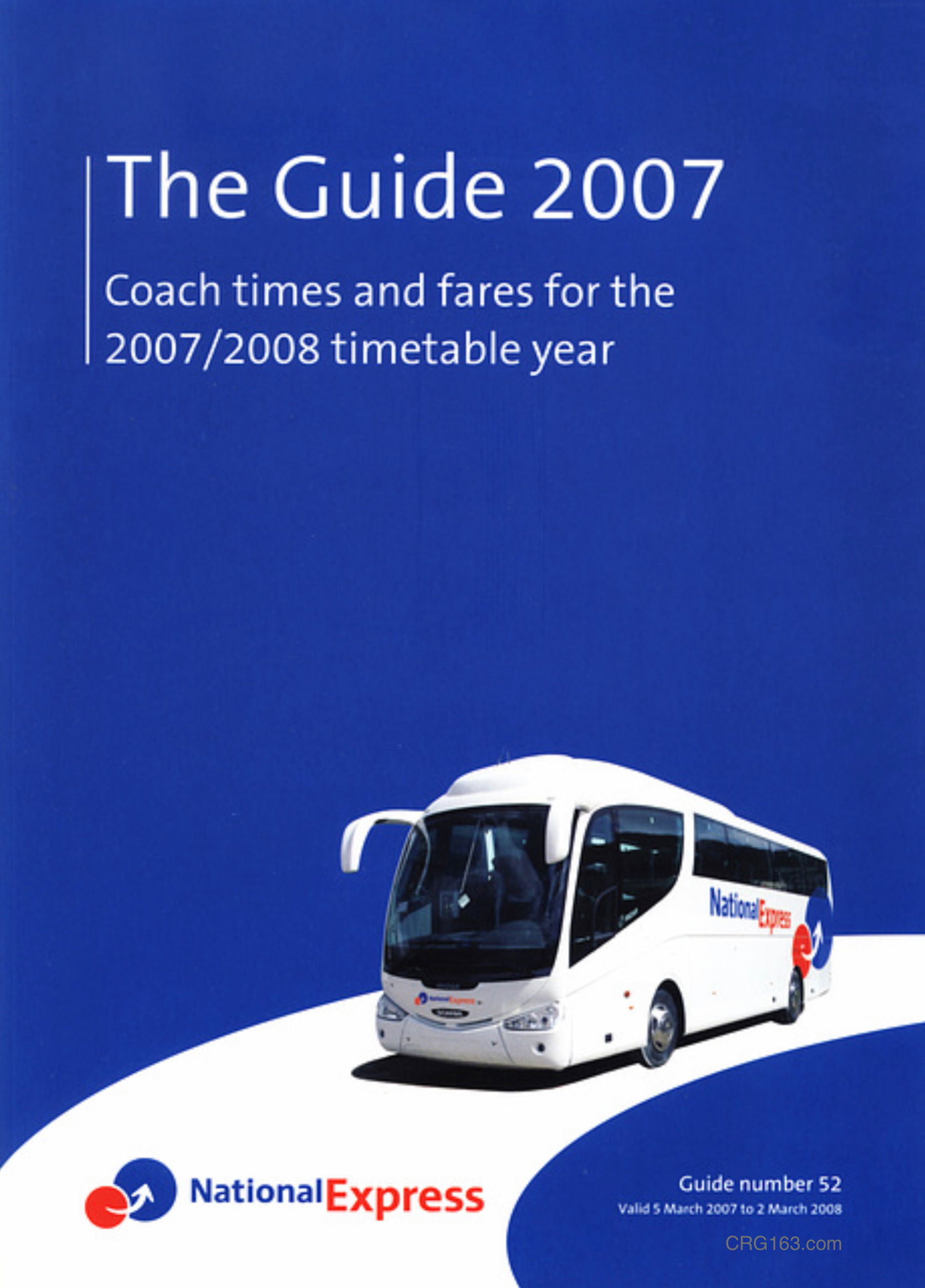 National Express Coach Guide - 2007/2008.
National Express Coach Guide - 2007/2008.In aligning its presence and operations in Spain the company acquired Continental Auto in April 2007, being the second largest bus and coach operator in Spain at the time with The Kings Ferry purchased in November of the same year. The company also launched an airport to hotel mini bus shuttle service but this ceased operations the following year in November 2008 as it did not reach the anticipated success required to be sustainable.
November 2007 saw National Express announce plans to introduce uniformed company branding across all of its operations. This involved dropping the circle to circle logo in 2003 with dot to dot grey stripes and a new lower case type font that consisted of curvier lettering, a mire rounded typeface.

The new branding was launched on the 9th of December 2007 on the new railway franchise now called National Express East Coast, formerly GNER operating rhe InterCity East Coast franchise. During the following month the new branding began to be rolled out across the coach fleet; on National Express West Midlands (formerly Travel West Midlands) on the 4th of February 2007 and then on National Express East Anglia (formerly One Railway) on the 26th of the the same month.
In May 2008 National Express sells Travel London and Travel Surrey to Abellio.
On the 18th of December 2009 the new Birmingham Coach Station is officially opened by Fabio Capello, replacing the previous Digberth coach station. The original interchange was built in 1929 as a bus depot by Midland Red, which was later converted into Digbeth Coach Station. The old coach station closed in November 2007 for redevelopment. The new interchange would be called Birmingham Central Coach Station. The refurbishment was estimated to have cost £15 million. It also received a BREEM ‘excellent’ rating. BREEAM is an assessment undertaken by independent licensed assessors using scientifically-based sustainability metrics and indices which cover a range of environmental issues. More details about BREEAM can be found by clicking HERE.
February 2013 sees National Express Germany awarded with two regional rail contracts by the Verkehrsverbund Rhein-Ruhr, Zweckverband Nahverkehr Rheinland and Zweckverband Nahverkehr Westfalen-Lippe authorities. These contracts commenced operations in December 2015.
Also during 2015 the Bayerische Eisenbahngesellschaft announced that National Express had been selected to operate the Nuremberg S-Bahn system, to commence operations from December 2018. This would be the first Deutsche Bahn S-Bahn network to be operated by a private operator. However during 2016 National Express withdraws sighting a delay in the ability to order new rolling stock.
June 2015 brought an announcement that parts 2 and 3 of the Rhein-Ruhr-Express would be operated by National Express to be introduced in 2018.
On the 8th of September, 2016 Plymouth Coach Station opens. Construction on the coach station began in January 2016. It replaced Bretonside bus station. In the same year National Express becoming an accredited Living Wage Foundation employer.
On the 16th of December 2016, respected family owned independent Clarkes of London was purchased, a coach operator comprising of 56 vehicles.
March 2020 sees Lucketts Group being purchased by National Express. The group at the time of purchase included Lucketts Travel, Coliseum Coaches, Mortons Travel, Solent Coaches and Worthing Coaches and was the largest coach operator on the South Coast employing 350 people and operating a fleet of 160 coaches and buses.
On the 3rd of February 2020 it was announced that Dublin Express would launch in March of the same year connecting Dublin Airport and the city centre, running on a 24hour basis. Three routes would be introduced with a phased expansion of the network.
By this point National Express was already operating 1,100 airport services every day on a 24 hour basis direct to the terminals of all UK airports including Gatwick, Luton, Stansted, Heathrow and Manchester. Further details are available HERE if the services presently being provided.
Rapide Services
National Express introduced the Rapide services in 1981 which would provide passengers with on-board tea/coffee services and sandwiches served by on-board hostesses. On-board television and toilet was also provided on vehicles operating under the brand. Rapide services were heavily marketed through its branding and extensive advertisement campaigns. Such branding would be displayed on the side of coaches, leaflets, posters etc.
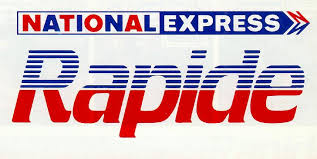
 Crosville Cymru/Wales Leyland Tiger CTL65 (C65 JTU) parked outside the company‘s Llandudno Junction depot (which was also its headquarters) in National Express Rapide branding.
Crosville Cymru/Wales Leyland Tiger CTL65 (C65 JTU) parked outside the company‘s Llandudno Junction depot (which was also its headquarters) in National Express Rapide branding.
A Plaxton Paramount 3500 coach as shown on the front of a National Express Rapide leaflet cover of the time promoting the brand.

National Express phased out the Rapide offering and branding in April 2001. It’s on board television service had already been withdrawn in the 1990’s.
However in late 2004, National Express introducing NXTV/National Xpress Television showing various episodes of British Television series. This was short lived as it was phased out in the summer of 2006. However in more modern times National Express now offers free WiFi on most of its coach services.
Branding changes over the years
Since 1972 National Express’s branding has changed significantly over the years, from it’s early days as depicted on CRG163 to present times. The different core branding adopted by the company over the years is represented below including the periods of operation.
1972 - 1982

1974 - 1982

1982 - 1991

1991 - 2003

2003 - 2007


2007 - present


Vehicle liveries
Predominantly coaches operating on National Express carry an all over white livery.
In the 1980’s coaches operating on National Express services developed an attractive ‘venetian blind’ (as its referenced) branding of blue and red, together with the white coach and National Express name as reproduced below. Some companies such as Crosville also applied black paint around the vehicle’s front windscreen. Some companies also applied black paint to the lower skirt of the vehicle.

In the 1990’s the ’venetian blind’ livery gave way to a much crisper and cleaner version as reproduced below. Vehicles remained white and still carried the National Express name. The application of black paint around vehicle windscreens and lower skirts was also replaced by white only.

Additional branding used
Over the years other liveries have also been carried on National Express services depicting specific branding on services that operated to Ireland, airports and Europe. Some of these are depicted below.
Supabus
The 'Supabus' name was once used in the 1980’s to promote services between London and other UK destinations to destinations in Ireland such as Belfast, Cork, and Galway also. Such services operated under the Supabus brand was jointly operated by Bus Éireann and National Express.
In one marketing poster dating from 16 April 1988, the Supabus service was marketed as “Travelling to Ireland by Supabus isn’t only comfortable and cheap - it’s trouble free too. For many destinations the same luxurious seat carries you all the way. Reclining seats and toilets.”

Other branding has also been used by National Express over the years to promote specific services such as Rapide. This has included services across to Ireland under the Supabus branding in the 1980’s to FlightLink promoting airport services.
Caledonian Express?
In October 1989 National Express acquired the Scotland-England coach services of Stagecoach when its agreement with Scottish CityLink came to an end and created a Scottish subsidiary with the brand of Caledonian Express operating from Stagecoach’s old depot at Perth. The branding for Caledonian Express below. The branding ceased in 1993.

Eurolines
Acquired by National Express in 1993.
 Flightlink
FlightlinkFlightLink was a brand initially operated by Flights Coaches of Birmingham, taken over by National Express in 1996. For a period such services would continue to operate under the Flights Coaches cream and black livery but with the famous “double-N” logo applied.

Express Shuttle
National Express also operated a variant of their own branding on airport services titled ‘Express Shuttle” which would comprise of a dark grey skirting applied to vehicles used. However in 2007 all branding was simplified as shown above.
‘Express Shuttle’ livery was used on the Cambridge to London service as well as on the Poole-Bournemouth-London service 032.

GobyCoach
Early to mid 2000’s the GoByCoach.com website was created by National Express and this graphic design was carried by the coaches operated on the network. A large variant of the logo would also appear on the side of coaches in green.
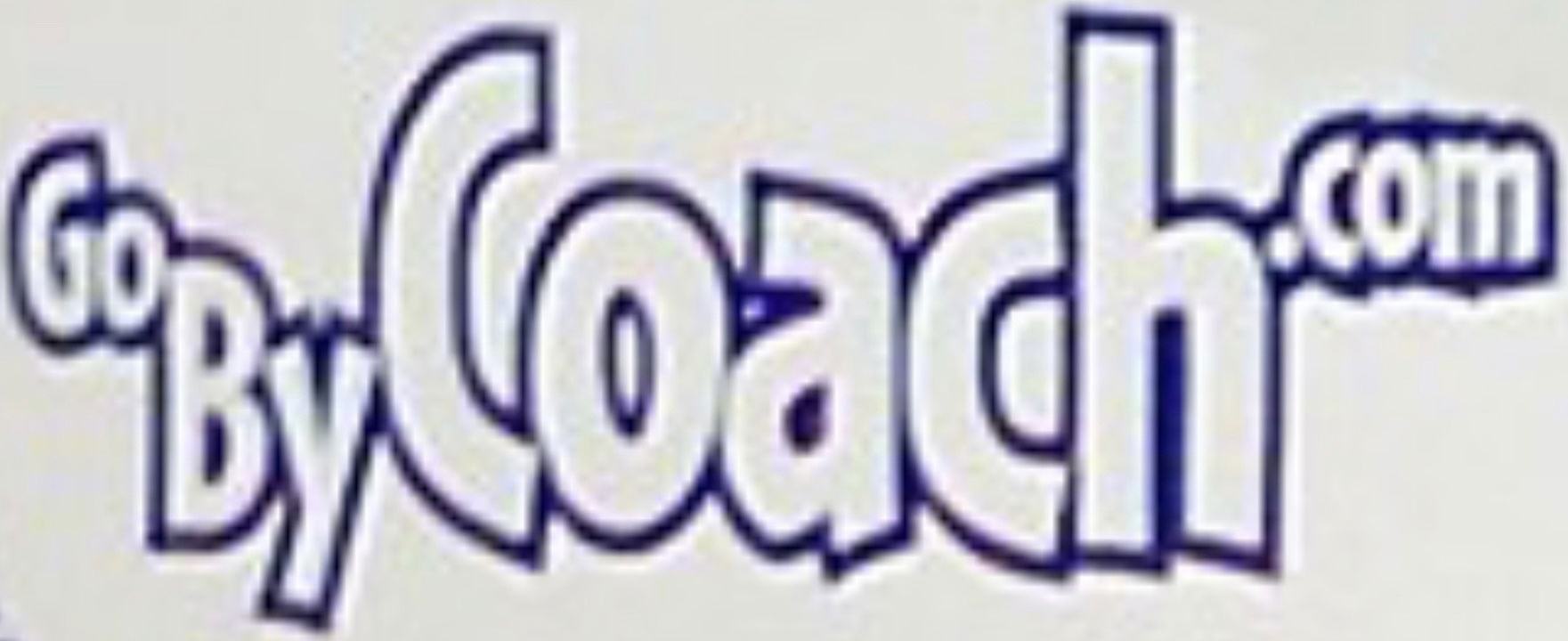
Jetlink


National Express Airport
The Airport brand was created in 2003 when the National Express image brand was updated, merging the former Airlink, Flightlink, Jetlink and Speedlink brands. This was however dropped in 2007 when the company introduced a uniform brand and image across all operations.
Other livery variants
National Express have also used a number of other liveries over the years through various acquisitions and marketing opportunities.
Airports
In the 1990s National Express Group moved into the privatisation of airports, eventually purchasing East Midlands Airport, Bournemouth Airport and Humberside Airport. In a move to concentrate on bus and rail provision, the airports were sold to Manchester Airports Group for £241m in March 2001.
Until November 2007, the group also operated Stewart International Airport in New Windsor, New York. However, the lease was sold to the public Port Authority of New York and New Jersey.
Vehicles
Over the past 50 years of operation many vehicle types have been employed on National and then National Express services. This has ranged from the majestic ECW coach on a Bristol RELH chassis powered by a Gardner engine like CRG163 to the Caetano Levante III (introduced July 2018) which seems to be the favoured vehicle at the moment. Other such vehicles have included the dual purpose ECW bodied RE; Leyland Leopards (on Plaxton Elite/Dominant Duple body variants); Leyland Tigers (on various body variants from Duple Caribbean to Duple Laser); Bovas; MCW; the first Expressliner in the form of the Plaxton 3500 powered by Volvo; Van Hool Alizeé bodied Volvo B10M; Jonckheere Mistral bodied Volvo B10M; Plaxton Premiere; Plaxton Paragon and now the Caetano Levante.
Publicity
Over the years NATIONAL and then National Express have embarked on many publicity opportunities to promote it’s network and services which has ranged from general promotional leaflets and timetables, Beeper the frog to promotional advertisement which has included David Soul, better known as Hutch from the 1970’s American Cop show Starsky & Hutch.
National Bus Company
One of the strap lines used by the National Bus Company back in the day.

Beeper the Frog
Beeper the Frog makes an appearance in promoting cheaper fares on National Express services in the 1980’s.
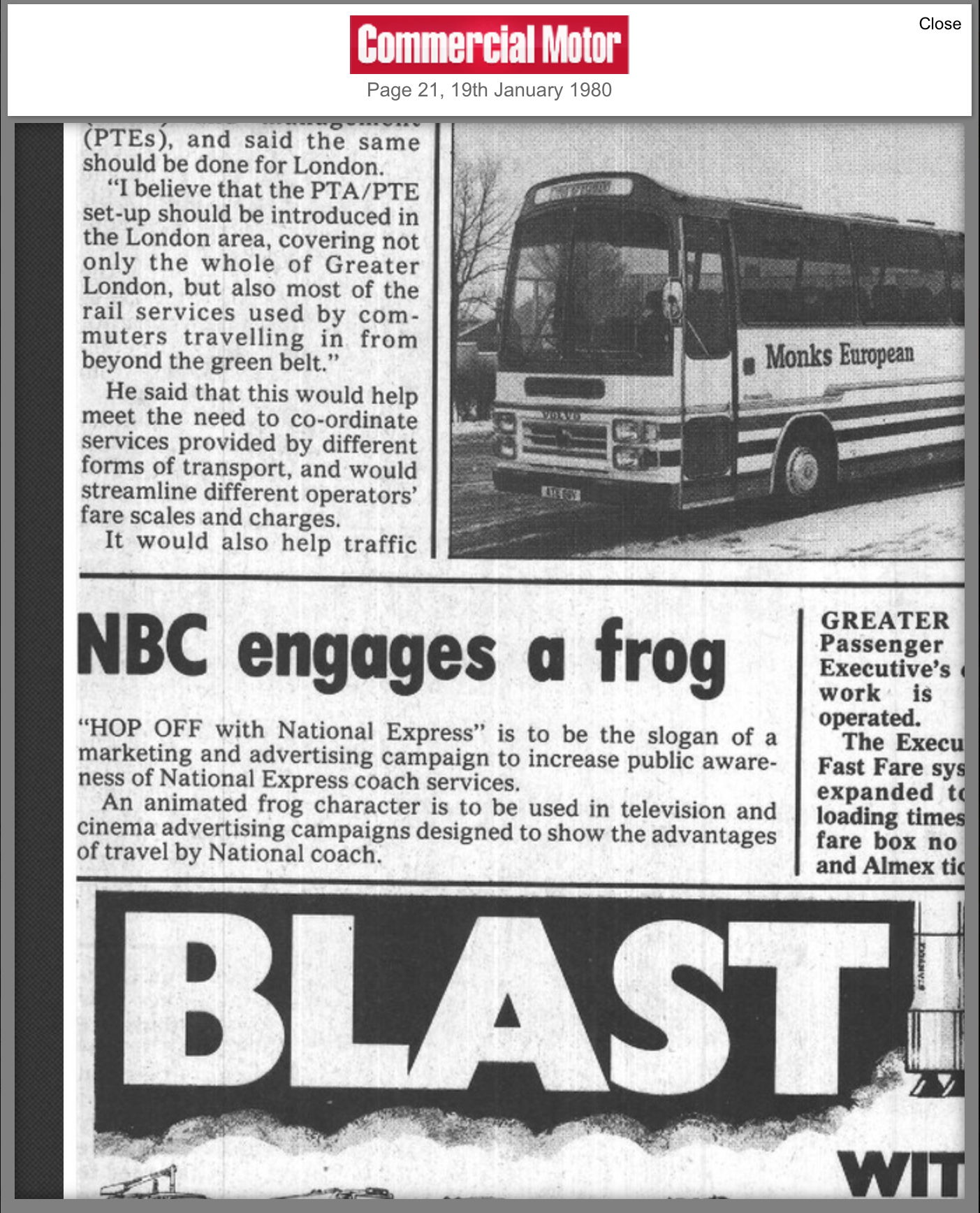



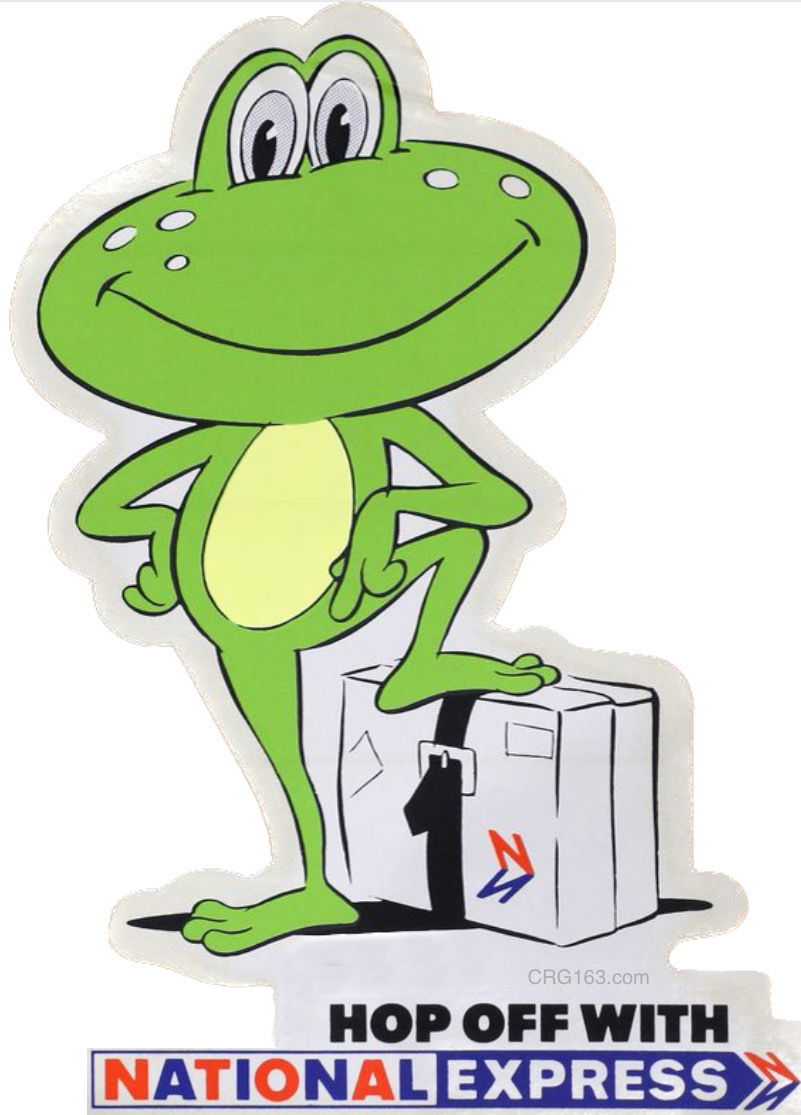
Leaflets, posters and timetables over the years
National Express have produced a plethora of promotional material over 50 years ranging from leaflets advertising service timetables, products available, ticketing and branding. Below is a collage of many leaflets produced over many years.
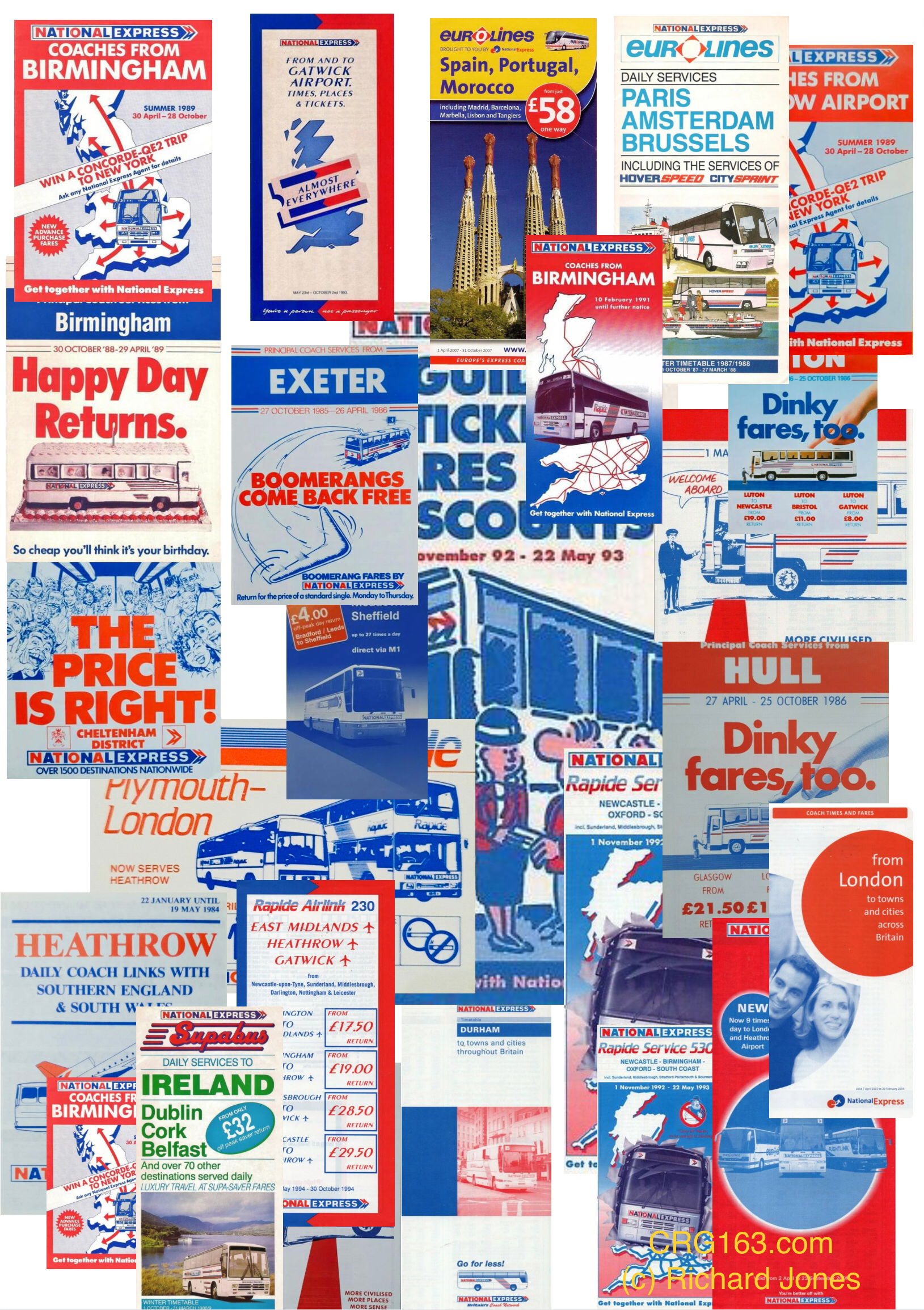
National Express Rapide cardboard coasters
During the Rapide era many publicity leaflets and posters were produced to advertise the brand. Cardboard coasters displaying an MCW coach in the National Express Rapide livery and branding were also produced including biros.

Divine Comedy - ‘National Express’
In 1999 further publicity came to National Express in the shape of Devine Comedy which provided a feel good song about National Express.
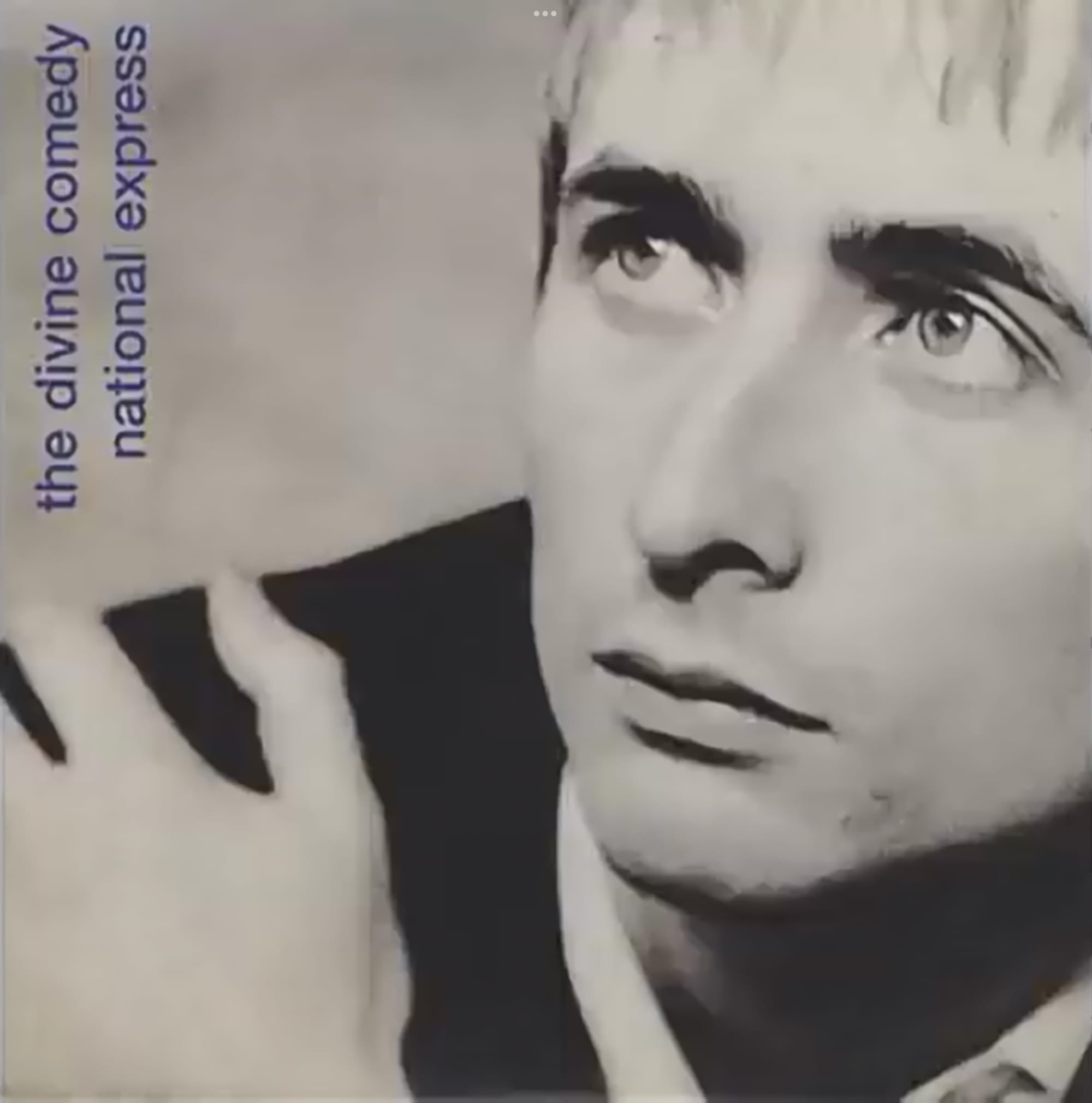
The Divine Comedy - ‘National Express’ 1999.
To listen to the Divine Comedy’s ‘National Express’ song via You Tube click on the image above or click HERE .History of coach travel in the UK
National Express celebrates 40 years by sharing the video below on line.

To see the short film via You Tube click on the above image or click HERE.
National Express celebrates 40 years of coach travel
During 2012 National Express celebrated 40 years of coach travel and as a part of this released the following on-line video - 20.09.12.

To see the short film via You Tube click on the image above or click HERE.
National Express presence via on-line platforms
Below are only a few examples of many on line videos produced by National Express in recent years in promoting the brand and product offered. National Express have come a long way since its early days.
David Soul - Silver Lady
The late David Soul from Starsky & Hutch fame behind the wheel of a National Express Caetano Levante coach - 14 June 2014.
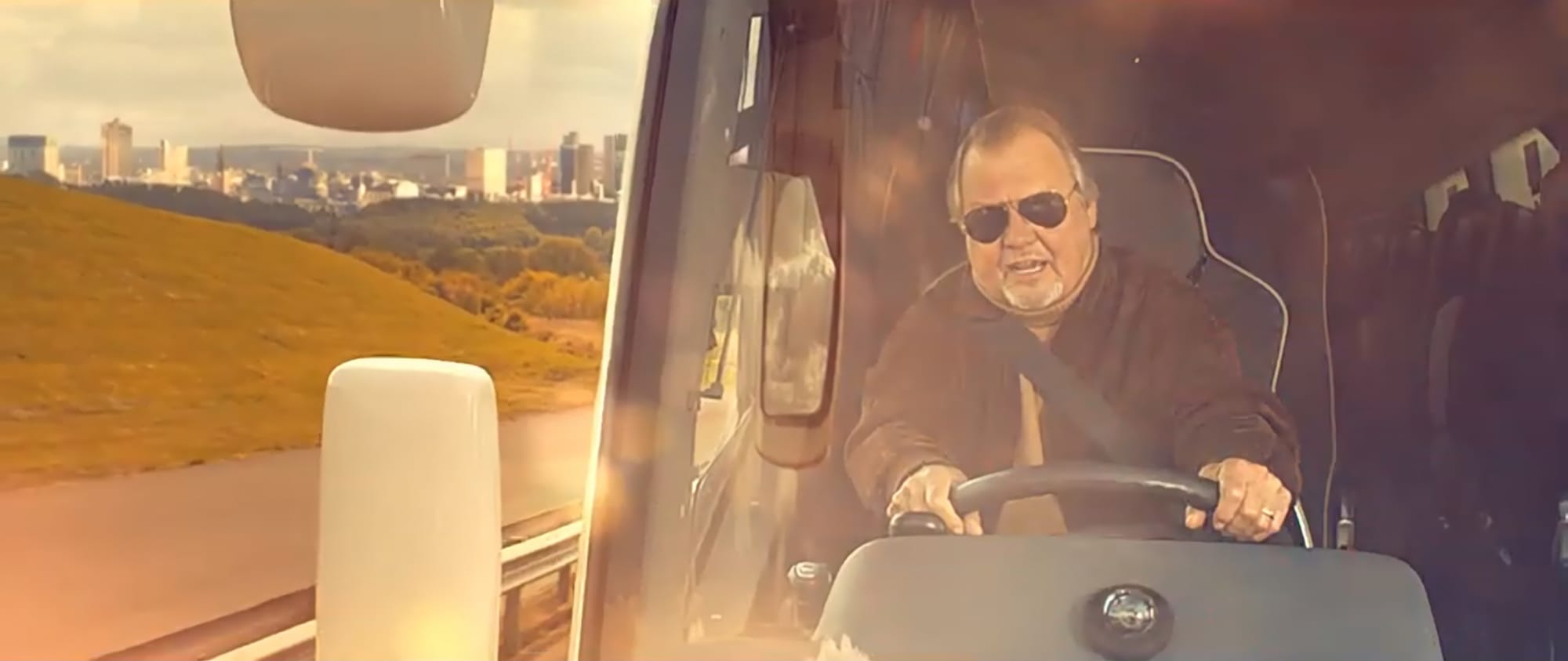
David Soul of Starsky and Hutch fame singing Silver Lady as he drives a Caetano Levante in the advertisement.
To see the full advert via You Tube click on the image above or click HERE.National Express - Go Get It
National Express launched a 20 second video in 2025 titled Go Get It.

To see the advert via You Tube click on the image above or click HERE.
National Express - Take a Different View TV ad
National Express launched a 43 second TV ad in February of 2016 featuring the Levante coach.

To see the advert in full via You Tube click on the image above or click HERE.
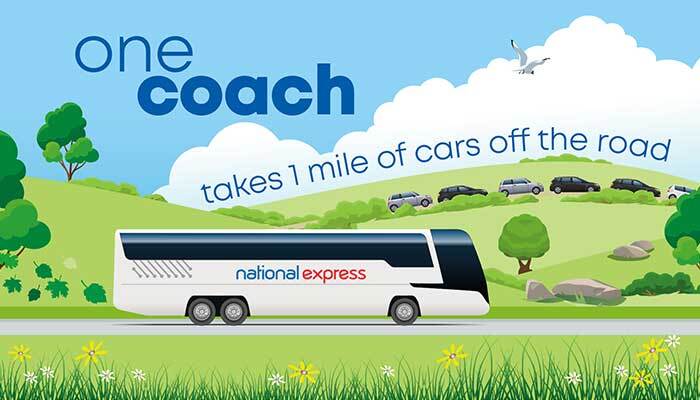
National Express statistics
At the time of writing (05.01.23) the following statistics are current:
National Express coaches have journeyed 3.8 billion miles across the length and breadth of the UK since 1972 to 2022 (50 years of operation)
A national network links more than 540 locations, including 59 of the UK mainland's 76 cities
1,800 plus services operate every day, increasing to over 1,900 on Fridays
Over 1,000 airport services a day run direct to the terminal for all major UK airports
The Fleet
National Express and its franchisees operate a limited number of coach types. Primarily standardising its main coach operation on the Caetano Levante body on Mercedes-Benz, Scania and Volvo chassis. The Levante was designed between 2003 and 2005 by Portuguese coach builder Salvador Caetano and National Express exclusively for use on their network, equipped with a wheelchair lift at the front entrance door, and could be built on either two or three axels depending on chassis configuration. The most recent tri-axle Levante III was introduced onto the network in July 2018, with an updated version named the Levante IIIA introduced from late 2022.

The future
The future for National Express is bright, although competition continues from various sources including Stageocach MegaBus and FlixBus. The National Express Group is now the Mobico Group, a multinational public transport company.
The company operates bus and coach services through the National Express brand as well as train services in the Republic of Ireland, Eurolines in connection with Bus Éireann, USA, Canada, Spain, Germany and other countries involving long distance coach services across Europe.
National Express Transport Solutions

National Express Transport Solutions provides transport for businesses. Whether it relates to staff transport, one-off event shuttles or a long term bespoke network.
it works with clients such as See Tickets, Metropolitan Police and the BBC, and provided services for a multitude of industries. From transporting employees to their place of work on a daily basis to providing hundreds of coaches for events like Glastonbury, a huge range of services are offered, all tailored to the needs of businesses.
Travel had also been provided travel for a number of UEFA Champions League Finals, as well as having transported David Cameron around on a custom wrapped ‘Conservative Battle Coach’.
My own connection with National Express
You may be wondering what is my own connection with National Express? Over the past 32 odd years (2022) of working in the bus industry I‘ve had a few connections as I remember below.
Early influence
Even before any direct career connection with the bus industry I had always been interested in working for the industry one day from school. Below is a painting I made in school when I was about 14/15 years old. It is of Crosville Wales Leyland Tiger Laser 2 B151ALG (fleet number CTL51). The vehicle depicts National Express’ venetian blind livery, operating the 709 service from Pwllheli to Liverpool, departing Blaenau Ffestiniog.

Bangor Clock Travel Office
My first paid job and that in the bus industry started with Crosville Wales at it’s travel office at the Bangor Clock bus station on school holidays. I would catch the first bus out of Blaenau Ffestiniog at 0715 having travelled by bike initially from Tanygrisiau, keepin my bike at the depot. I would then change buses in Caernarfon to get to Bangor before doings the journey in reverse in the evening, eventually getting back home for around 1930hrs (07.30pm).
At the Bangor Town Clock office not only would we provide general bus travel information and the selling of weekly and monthly travel cards but the little office was also a National Express agent. As an agent we would provide travel information on all National Express services including cost and would also sell travel tickets to passengers via the paper tickets including booking subsequent journeys on the little computer system linked to the wider network. This would book a seat for passengers on the services they were about to travel on in the coming days. The computer screen looked very similar in appearance of graphis to the ild Ceefax system to give you an idea but simply dealt with National Express coach bookings. This was in the late 1980’s.
When I was old enough to drive a car I’d also cover at the company’s similar travel office at Rhyl bus station. Living in Tanygrisiau, Blaenau Ffestiniog it would have been logistically impossible to get to Rhyl by public transport for a day’s work.
Crosville Wales shunt driver
When I was a bus driver with Crosville Wales in the early 1990’s as I was under 21 years old I could only drive up to 50KM’s from the depot I was based in accordance with the regulations. Once becoming 21 years old it was a different story and mileage was no longer an issue. once I reached 21 years old I would drive on Crosville’s Cymru Coastliner service which used double deckers with dual purpose coach seats between Caernarfon and Chester. That is another story covered elsewhere on this website.
When I drove buses from Crosville Wales’ Pwllheli depot there would be local service bus duties that would involve driving the National Express 580 service (Pwllheli - Newcastle) either from Pwllheli to Caernarfon or vice versa In it‘s return in the evening. The vehicle used to operate the service was based at Pwllheli depot. This was simply a shunt as we would call it in supporting the main drivers and their drivers hours. On one occasion I got the opportunity to drive the 580 service back from Caernarfon one summer's evening to Pwllheli via Porthmadog.
The vehicle in question was one of the three Duple 425's - E611AEY to E613AEY.
National Express driver 2002 - 2005
In 2002 I was asked if I could cover the North West end of the 545 service (Pwllheli - London) as a driver on Saturday over a few weeks. Providing driver cover for only a few weeks ended up driving the Pwllheli end of the service every Saturday for two years including here and there during holiday periods. The 545 service at this time was provided on behalf of National Express by First Wessex / First Southern National, managed from its operational base at Birmingham by the capable Clive Lee. Clive had been a driver at one point but was now heading up the operation for First at Birmingham and Bristol. Other services included those to Manchester and other destinations. Clive was highly respected by all who worked for him.
The Pwllheli based driver would start off the London bound service at Pwllheli, departing at 0800am and drive to Llandudno in service. At Llandudno the service would be become double crewed by two drivers, i.e. the driver from Pwllheli and a driver from the Birmingham depot who had stayed in Llandudno the night before (having operated the north bound service the previous day with one of the other members of the Pwllheli based team) drove the service onwards to Chester. The Pwllheli driver would drive again from Chester to Stoke on Trent (Hanley bus/coach station). On arrival at Stoke on Trent at approximately 1330hrs (01.30pm) the Pwllheli driver would alight from the vehicle before picking up the northbound 545 service from Hanley at approximately 1500hrs (3pm) that had departed London at 1030 the same day. The same pattern of shared driving as the morning would be repeated but in the opposite direction arriving back in Pwllheli at around 2030hrs (if on time). The southbound service (that had started from Pwllheli at 0800am) would depart from Hanley and continue with a shunt driver to Birmingham with another driver from Birmingham taking the service onwards to London, arriving London Victoria Coach Station at approximately 1800hrs. Service timings would suffer considerably over the summer holiday months due to congestion across the North Wales coast and motorways between London. Due to the high demand for the service back then many duplicate vehicles would be employed from operators near and far.
The Pwllheli end team of the operation consisted of Evan Herbert (ex Crosville Pwllheli depot); Derek Roberts, Gwilym ‘Berch’ Williams; Wyn Pete and myself, Richard Jones,
Drivers from the Birmingham team included Rob Hatton; Johnny Green (now sadly passed away); Mickey Perks; Leon Walker; Linzel; Phil; all professional people and true ambassadors for National Express and First Bus (the operating company on behalf of National Express) and also truly brilliant people to work with.
Below I include a few photos from my time as a driver on National Express.

Me arriving back in Pwllheli one evening on the 545 with Plaxton Premier R943 LHT (fleet number 186 with First) powered by the trusted Volvo B10M.

Another angle of me arriving back at Pwllheli one evening.

A nice early summer’s morning in Pwllheli before setting off on the 545 with the ‘Poppy coach’ as we all referred to R813 HWS. An EFE model of the vehicle was commissioned in both variants of poppy.

WX51 AKY (fleet number 6304 with First) on my arrival back in Pwllheli one summer’s evening. This was the next generation vehicle at the time from the Plaxton Premier. This was the Plaxton Paragon powered by a Volvo B12.
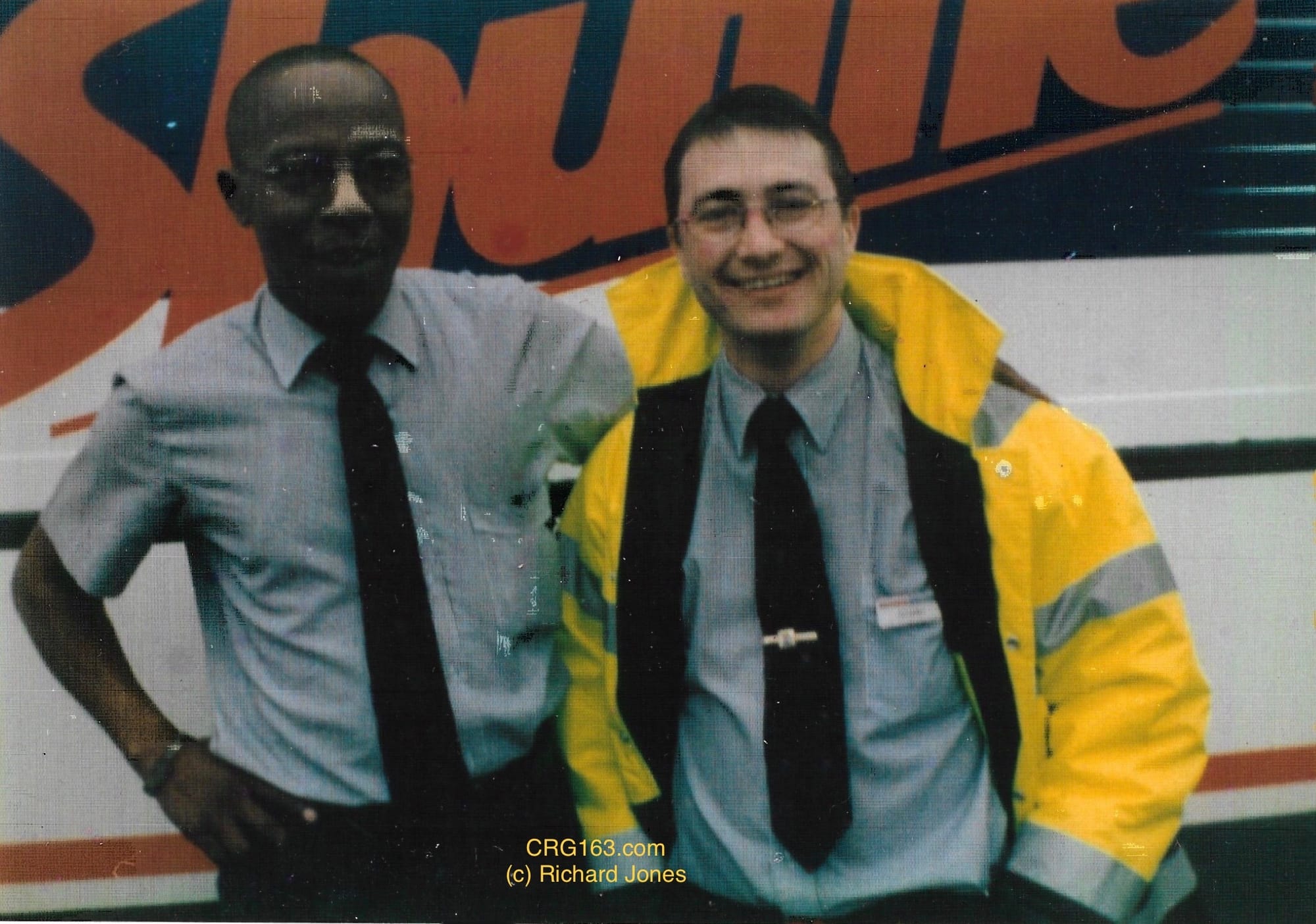
This photo was taken on request by two elderly ladies who travelled on the 545 service from London to Gronant near Prestatyn of Linzel and myself.

Another photo taken by the same elderly ladies, travelling again on the 545. This time the image is of Leon Walker and myself.
CRG163 - preserved Crosville coach in NATIONAL livery
My third connection with National Express is of course my very own preserved Crosville coach which has been painted in the first NATIONAL livery that was introduced in 1972 under Sir Frederick Wood’s leadership. My ownership of CRG163 began on the 9th of June 2002. Whilst there are several fantastic examples of other similar Crosville coaches in the wonderful cream and black coaching livery my decision to restore CRG163 to the NATIONAL livery of the day was to depict another important era of coach travel across the UK.
I was brought up during the National Bus Company era of bus and coach operation and I have fond and happy memories of travelling on Crosville buses and coaches during my childhood which have been captured elsewhere on this website. The ’double N’ logo is therefore an important personal reminder to me of this period as well as my various connections with National Express as detailed above. Before CRG163 was painted in this livery with the double ‘N’ logo applied special care was taken to seek and receive permission from National Express to be allowed to use the branding ‘NATIONAL’ and double ‘N’ logo in 2003. My thanks to National Express for this.

Preserved Crosville CRG163 parked at Woodside, Birkenhead at the beginning of October 2004. CRG163 had attended the Wirral Bus & Tram Show before an impromptu trip to Liverpool Lime Street, CRG163’s old stomping ground when based at Crosville’s Edge Lane depot from new in 1970. The above photo was taken at a location these coaches would stop at on a daily basis when operating long distance services for Crosville and under the NATIONAL brand. This is a photo that National Express has also used within its 50 year celebrations and official photos - please see below.
The famous double ’N’ logo reproduced in 3D
Christmas 2023 saw my youngest son (11 years old) receive a 3D printer as his main Christmas present. Subsequently my eldest son (14 years old at the time) created a digital 3D model through specific computer software of Norman Wilson’s famous logo taken from a 2D digital image and together produced a one off gift for me, for their Dad.
How times have changed over the years as I remember reproducing the same logo when I was their age, but then it involved a pencil a ruler and a piece of paper! Thank you boys for such a wonderful present. Still trying to remember that you are only 11 and 14 years old at the time of writing this entry on our website!
Hard to believe that this logo was created 50 years ago at the time of writing. What would Norman Wilson have to say I wonder?


Happy 50th National Express
This page is not a promotional platform for National Express, but a mere page summarising the history of National Express and a name that has been synonymous with coach travel in the UK since 1972 and it’s link to CRG163, Crosville, Crosville Wales and myself.
Happy 50 years National Express with very best wishes!
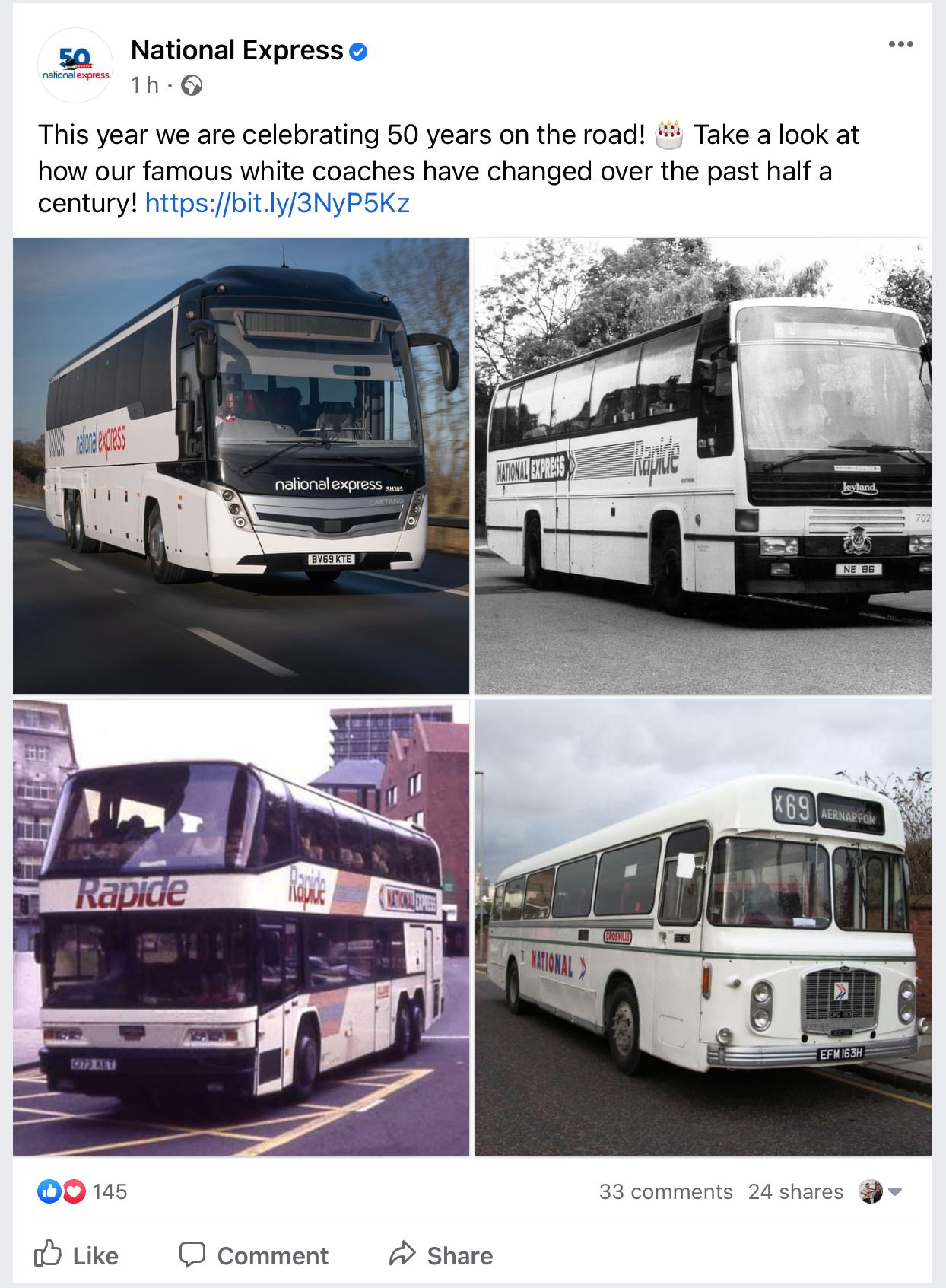
An official release by National Express on it’s Facebook page celebrating 50 years. Note CRG163 - bottom right corner image!

Official publicity produced by National Express to celebrate 50 years, with kind permission to reproduce on this website.
Contact details
If you have any photos or related information about CRG163 or any information on the parts presently required then please e-mail me, Richard Jones at post@crg163.com . Many thanks in advance.
